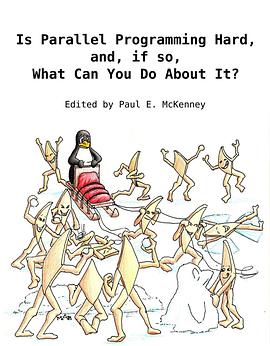Is Parallel Programming Hard, And, If So, What Can You Do About It?
内容简介
The purpose of this book is to help you understand how to program shared-memory parallel machines without risking your sanity.1 By describing the algorithms and designs that have worked well in the past, we hope to help you avoid at least some of the pitfalls that have beset parallel projects. But you should think of this book as a foundation on which to build, rather than as a completed cathedral. Your mission, if you choose to accept, is to help make further progress in the exciting field of parallel programming, progress that should in time render this book obsolete. Parallel programming is not as hard as it is reputed, and it is hoped that this book makes it even
easier for you.
......(更多)
作者简介
Paul McKenney is a Distinguished Engineer and CTO of Linux at
IBM's Linux Technology Center (LTC). He is the maintainer of
the Linux kernel's implementation of RCU and a contributor to
the user-level implementation. He chaired the Linux Plumbers
Conference Program Committee in 2009 and 2011, and served on
the Linux Kernel Summit Program Committee in 2010 and 2011.
He has published one netbook, one book chapter, and more than
one hundred papers and presentations, and holds more than 80
patents in the USA, PRC, and elsewhere.
......(更多)
目录
1
Introduction
1.1 Historic Parallel Programming Difficulties . . . . . . . . . . . . . . . . .
1.2 Parallel Programming Goals . . . . . . . . . . . . . . . . . . . . . . . .
1.2.1 Performance . . . . . . . . . . . . . . . . . . . . . . . . . . . .
1.2.2 Productivity . . . . . . . . . . . . . . . . . . . . . . . . . . . . .
1.2.3 Generality . . . . . . . . . . . . . . . . . . . . . . . . . . . . . .
1.3 Alternatives to Parallel Programming . . . . . . . . . . . . . . . . . . . .
1.3.1 Multiple Instances of a Sequential Application . . . . . . . . . .
1.3.2 Make Use of Existing Parallel Software . . . . . . . . . . . . . .
1.3.3 Performance Optimization . . . . . . . . . . . . . . . . . . . . .
1.4 What Makes Parallel Programming Hard? . . . . . . . . . . . . . . . . .
1.4.1 Work Partitioning . . . . . . . . . . . . . . . . . . . . . . . . . .
1.4.2 Parallel Access Control . . . . . . . . . . . . . . . . . . . . . . .
1.4.3 Resource Partitioning and Replication . . . . . . . . . . . . . . .
1.4.4 Interacting With Hardware . . . . . . . . . . . . . . . . . . . . .
1.4.5 Composite Capabilities . . . . . . . . . . . . . . . . . . . . . . .
1.4.6 How Do Languages and Environments Assist With These Tasks? .
1.5 Guide to This Book . . . . . . . . . . . . . . . . . . . . . . . . . . . . .
1.5.1 Quick Quizzes . . . . . . . . . . . . . . . . . . . . . . . . . . .
1.5.2 Sample Source Code . . . . . . . . . . . . . . . . . . . . . . . .
2 Hardware and its Habits
2.1 Overview . . . . . . . . . . . . . . .
2.1.1 Pipelined CPUs . . . . . . . .
2.1.2 Memory References . . . . .
2.1.3 Atomic Operations . . . . . .
2.1.4 Memory Barriers . . . . . . .
2.1.5 Cache Misses . . . . . . . . .
2.1.6 I/O Operations . . . . . . . .
2.2 Overheads . . . . . . . . . . . . . . .
2.2.1 Hardware System Architecture
2.2.2 Costs of Operations . . . . . .
2.3 Hardware Free Lunch? . . . . . . . .
2.3.1 3D Integration . . . . . . . .
2.3.2 Novel Materials and Processes
2.3.3 Special-Purpose Accelerators
2.3.4 Existing Parallel Software . .
2.4 Software Design Implications . . . . .
...
......(更多)
读书文摘
the primary goals of parallel pro- gramming are performance, productivity, and gener- ality.
......(更多)






